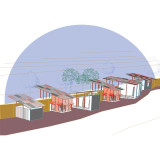The present study focuses on leveraging architecture for the development of alternative tourism, emphasizing hiking trails. Specifically in Evia, the natural beauty and geomorphology offer numerous opportunities for the development of sustainable tourism activities. Hiking is a key subject of study, as it allows for the promotion of the natural landscape and the advancement of alternative tourism. Architecture contributes through the design of trails and accommodations that harmoniously integrate into the environment, providing hikers with an enhanced experience.The research centers on creating a network of accommodations at strategic points in Northern Evia, designed with respect for the natural environment and cultural heritage. These accommodations, inspired by bivouacs and the ancient Greek concept of "Hestia," will be functional and sustainable, tailored to the needs of hikers for comfort and safety. The use of local materials, such as wood and stone, and the avoidance of harsh interventions in the natural landscape make these accommodations a part of the local nature.The study includes an analysis of geomorphological and meteorological data for selecting the most suitable locations. It also examines the needs of hikers, offering appropriate solutions for lodging, dining, and personal hygiene. The result is the creation of a comprehensive experience that promotes sustainability, connection with nature, and exploration of the landscape of Evia.
